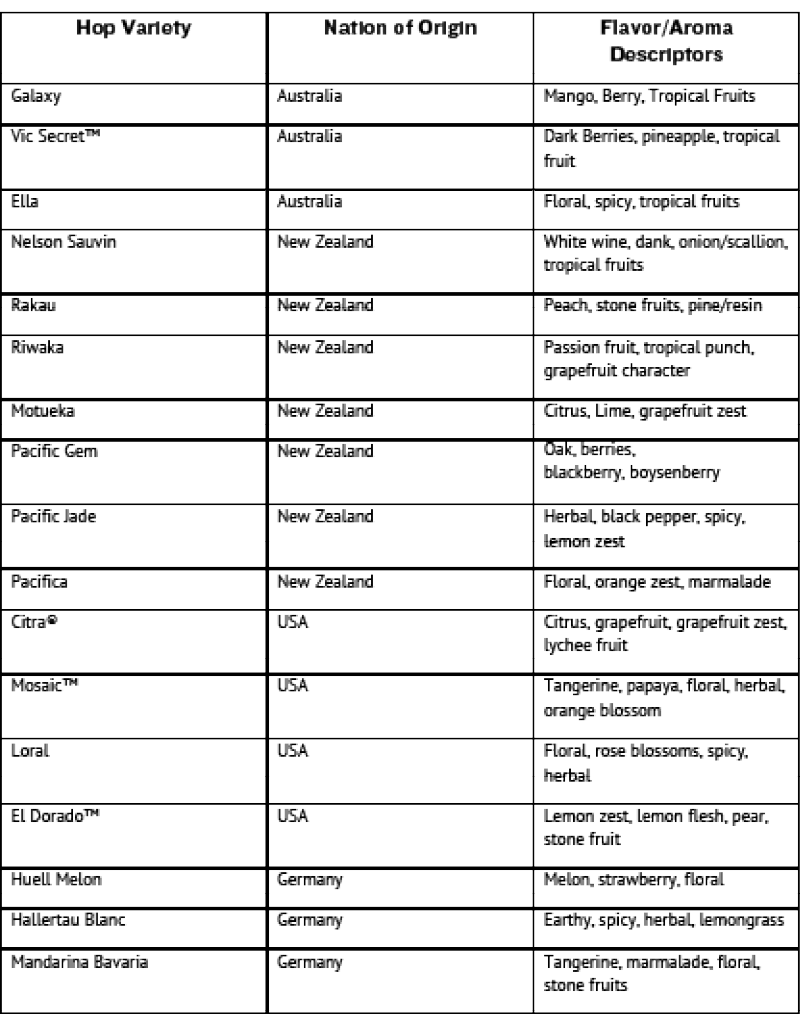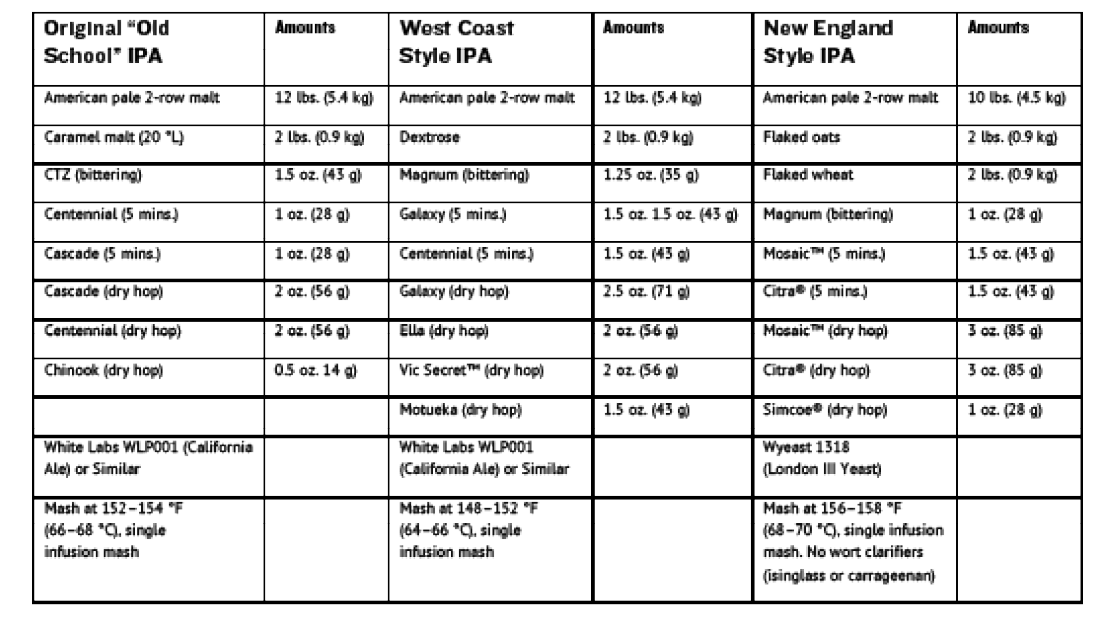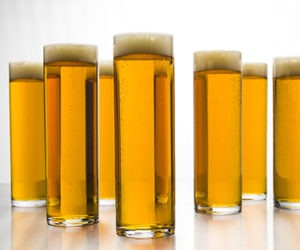Reformulate Old Recipes into New Homebrews
The last 30 years has been the era of craft beer. What started as slow and steady growth three decades ago of 20 or so breweries and less than 0.1% of the market share of beer, has blown up into over 5,000 breweries and a market share of 15%. This sort of success was laughable all those years ago, even by the staunchest of craft beer supporters. The paradigm has shifted and now craft beer is huge. And in that transformation, tastes have changed, even among craft drinkers. The sheer amount of breweries operating out there right now necessitates the need for each brewery to differentiate themselves from the rest of the field somehow. Old classics are now passé, everyone is looking for the new hotness. The mild pale ales that blew peoples’ minds 30 years ago are now considered old and outdated. And the ingredients that go into craft beers have followed suit. Hop breeders, once focused on breeding more alpha into their hops, are now focusing on unique aromas and flavors that craft brewers can use in their IPAs. Maltsters have invested a lot of time and money into new and different specialty malts to cater to the craft brewers’ need for innovative and unique styles. Every brewer is looking for the newest and sexiest hop and specialty malt.
The era of the flagship beer is drawing to a close, which is causing some venerable craft brewers to update the recipes of their classic recipes to make them relevant again. And for homebrewers, the new wave of ingredients, styles, and trends also signals a time to take a look at older recipes and make them new again.
A line from Oliver Stone’s 1991 movie “JFK” (and appropriated by Millhouse on “The Simpsons”) captures updating recipes the best: “We’re through the looking glass here, people.” Making changes to a flagship beer for an established brewery is tough financially, as well as psychologically. It’s never fun or encouraging when a well-established brand starts plateauing and even starts to decline. Pragmatism usually wins out and an update is mandated. What does that process look like? You must dive deeper into some of the new brewing ingredients that have popped up over the last few years and decide on a flavor that thirsty customers crave. And where there are thirsty drinkers, there are of course homebrewers — ready to try out the newest trends, techniques, and ingredients for themselves. There are also homebrewers who have recipes in their repertoire that have become classics at home, but maybe aren’t bringing home the hardware at homebrew competitions anymore. If that describes you, the time has come to take a fresh look at your recipe collection and make some updates.
Sprucing up IPAs
Most established craft breweries have at least one IPA available in their year-round lineup. The more venerable breweries made up those IPA recipes when the ‘C’ hops were the dominant craft varieties available to brewers for both bittering and aroma/dry-hops. Columbus, Cluster, Cascade, Chinook, Centennial, and sometimes Crystal consist of the “C” hops or “old school” varieties. They are typically high alpha and have a more resinous/pine and grapefruit aroma and flavor. Sierra Nevada Pale Ale famously uses Cascade as the dominant flavor and aroma hop variety and has that nice grapefruit and pine flavor character that highlights the older hops available in the early days of the craft beer revolution. A brewer looking to update their recipe from something with this old school profile has a veritable palate of hops to choose from to flavor their IPAs these days. Australia and New Zealand have been cranking out hops that have more of the “tropical fruit” character that people nowadays are craving. For example, Nelson Sauvin from New Zealand and Galaxy from Australia are some of the more popular varieties brewers use to give IPAs more of the mango and pineapple flavors.
Domestically, the Hop Breeding Company (a joint venture between Select Botanicals and John I. Haas) has turned out a lot of excellent flavor and aroma hops as well. Simcoe®, Citra®, and Mosaic™ are all distinguished alumni of this venture. Citra® (initially known as HBC 394) is known for its intense citrus aromas and flavors. Mosaic™ (HBC 369) is aptly named for aromas and flavors that play across the whole flavor palate. Most people get some bright fruit, resin, citrus, grassy, and a little bit of scallion from Mosaic™. Their newest variety out in the market now is Loral™ (HBC 291), which gives some more peppery and bright floral notes, along with the more traditional citrus flavors.
German hop growers are also breeding some new varieties of hops, most of which are now on the market. Most of these varieties are crossbreeds between Cascade and noble hop varieties like Hallertauer. Huell Melon has lots of nice melon and floral flavors, and Mandarina Bavaria has some tangerine-like aromas and flavors along with the floral character found in most noble hop varieties. Hallertau Blanc is the latest of a new line of Hallertau-derived hop varieties with more fruit character that’s not present in the traditional Hallertau Hersbrucker or Mittelfrüh. See the chart on the facing page for some newer hop varieties to consider when updating your recipes.
Yeasty Fun
There has always been a plethora of yeast strains available to brewers, but the more microbiologically savvy brewers have utilized more interesting varieties to spice up old recipes. For example, some craft breweries have brewed one-off versions of their flagships using Belgian strains in place of their usual American ale strains to try a more estery and spicy variation on their cleaner counterparts. Brettanomyces-fermented variants of popular brands have popped up as well.
The latest craze in craft and homebrewing is “hazy” IPA or Northeastern-style IPAs. The murkiness and high turbidity of IPAs have contributed to a lot more “juicy” IPAs with more contemporary hops and lower bitterness. Breweries have relied on some creative processing techniques to get the level of haziness people want, including late hop additions and choice of yeast strain, both of which can be contributors to the level of haze in a beer. Many pro brewers of this style use the London style yeast strains from White Labs and Wyeast, and others use some of the newer strains that are specific to this style, such as The Yeast Bay’s “Vermont Ale,” East Coast Yeast’s ECY29 (North East Ale), or Omega Yeast Labs’ “DIPA Ale.”
Malt Innovation
A lot of times malt doesn’t get enough credit. Obviously, it’s a crucial component in beer, but malt has been playing second fiddle to new hops and yeast strains for a while now. However, a great way to spruce up an older style is to swap in some new or unique specialty malts.
My personal favorite specialty malt to go to when reformulating a recipe is rye. Flaked rye and malted rye give a wonderful fruity and spicy flavor to beer and play a good supporting role to hops – especially the contemporary varieties that highlight tropical fruit flavors. The trouble with too much rye in the grain bill is the high beta glucan levels that tend to cause the lauter to gum up and could cause a stuck mash. With better lautering technology out there, however, and also the use of enzymes that can break down beta-glucans and arabinoxylans (betaglucanases and xylanases), most brewers can work around this potential issue.
While it’s been around for a while, liquid black malt extract has seen an upturn in use to add a darker color without the roasty taste. Sinamar® from Weyermann is the most famous of these extracts, and a little of it goes a long way. A lot of brewers use that to turn their regular IPAs into a black IPA. Debittered black malt like Weyermann Carafa®, Briess Blackprinz®, or Midnight Wheat malt also can do the job.
Flaked oats and wheat are often used in the creation of “hazy” or New England-style IPAs due to their high protein levels. The higher concentration of dextrins from the adjuncts will also lead to a fuller mouthfeel in beer.
And if you wanted to give your beer a vivid red color instead, then try some Red X malt from Bestmalz. This specialty malt can be used up to 100% in a grain bill to impart fermentable sugars and the vivid red it’s known for. Malting technology has come a long way over the last few years and we’re seeing some great innovation coming from the maltsters to keep up with the hop breeders and the craft beer movement.
Water
Water profiles are a hot topic in discussion among homebrewers, especially in online forums. It’s also been a huge topic of conversation with craft brewers that are opening additional production breweries on opposite corners of the country and trying to mimic the exact flavor profiles of their existing brands. Most breweries employ reverse osmosis filtration and the ability to blend back into city water to reduce the hardness of their water or to keep the water at a certain profile. Breweries known for West Coast IPAs often have higher levels of sulfate (>100 ppm) to increase the perceived bitterness of the IPAs. Calcium sulfate (gypsum) is a great mineral addition to help with pH balance of the mash and also adding in sulfate for the desired flavor profile.
On the opposite side of the country, “hazy” IPAs rely on softer water and higher chloride content in their water to give a softer bitterness profile. Calcium chloride is the mineral addition of choice for those hazier IPAs. Chloride ions in higher concentrations can give a “salty” taste to beers, but in the right concentration (100-175ppm), can impart a softer bitterness profile and let the “juiciness” shine through.
Designing An Improved Recipe
Now that we’ve covered some of the new ingredient and trends out there, let’s build on that with a specific example — the process of redeveloping an IPA (since that’s the most popular style out there in craft and homebrewing). The first step to design a new and improved recipe of an existing IPA is to figure out what flavors you want. More contemporary IPAs are now transitioning from resiny, grapefruit flavors to more of the tropical fruit and melon side of the flavor spectrum. Recently developed hops can help you out with this profile change. A lot of brewers will fixate on the hop variety rather than the flavor they want, but this target fixation can lead to trouble and end up muddling the flavors. Layering hops that exhibit the flavors you want is more important than cramming your IPA full of the latest experimental hops. “Older” hop varieties layer flavor and aroma extremely well with some of the newer varietals. Simcoe® and Mosaic™ match up well and give off an intense tropical fruit note. For more of an “orange juice” aroma, Citra® and Mosaic™ work great. It all depends on which flavor direction you want to go.
“Old” Recipe
A classic IPA recipe will have a grapefruit peel/resin/lemon rind flavor profile. The bittering rate is higher to target around 80 IBUs. To round that bitterness out, Caramel malt at 20 °L will increase the body and mouthfeel and impart a little color. The dry hopping is all “C hops” from Cascade to Centennial and a bit of Chinook. The mash profile is in range to let a clean fermenting yeast like California Ale or Chico to do its thing and ferment with lower esters to highlight the hops.
“New” Recipe
The first updated IPA recipe is modeled after a contemporary West Coast-style IPA. The idea is to have 100% pale malt and some dextrose to get a very dry finish. This dry finish will help highlight Australian and New Zealand hop varieties and give the beer a tropical fruit flavor and aroma to the beer. The bittering hops have been reduced slightly from the first recipe to still make the IPA crisp and refreshing. Lower bittering helps highlight sweeter fruits in the beer itself. If you can do so, I would recommend adjusting the mash water to get your sulfate levels between 100-200 ppm to account for the harder water that gives the West Coast-style IPA its signature bitterness.
“Hazy” Recipe
Lastly, we’ll go over an updated recipe in the other direction. New England-style IPAs are less bitter than their West Coast cousins and feature a protein-heavy grist of oats and wheat. This recipe also doesn’t use any whirlfloc or other clarifying agents in the whirlpool to preserve the haze. The dry hop stage is key here. Dry hop warm, and using Mosaic™ and Citra® to generate juicy hop flavors and aromas. A little Simcoe® in there will help with the overall depth of juicy flavor we like from the New England-style IPAs. If you can do so, I would also recommend adjust the mash water to get between 100-150 ppm chloride to help soften the bitterness and mouthfeel of the hazy IPA. See the comparison of these three variations on the same recipe in the chart below.
Get Updating
It’s time to dust off the recipes you haven’t brewed in a while and take a hard look at how you can make them a little more contemporary. A new hop here, a new malt there. Perhaps a whirlpool hop addition? Experiment and see if you can make a new version of a previously beloved beer!
A SELECTION OF NEWER HOP VARIETIES AND FLAVOR DESCRIPTIONS






